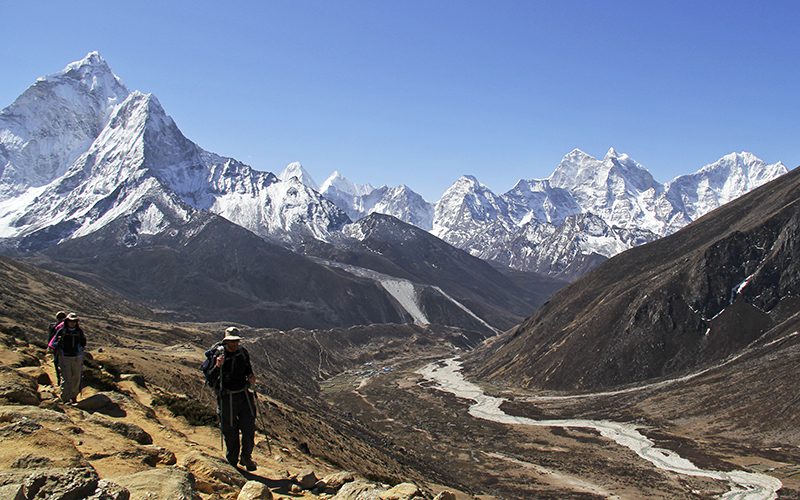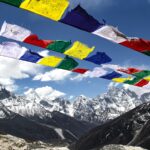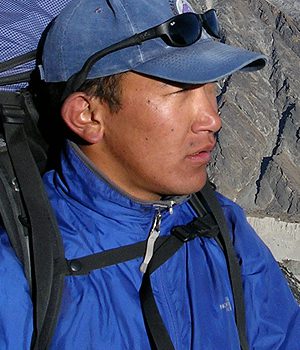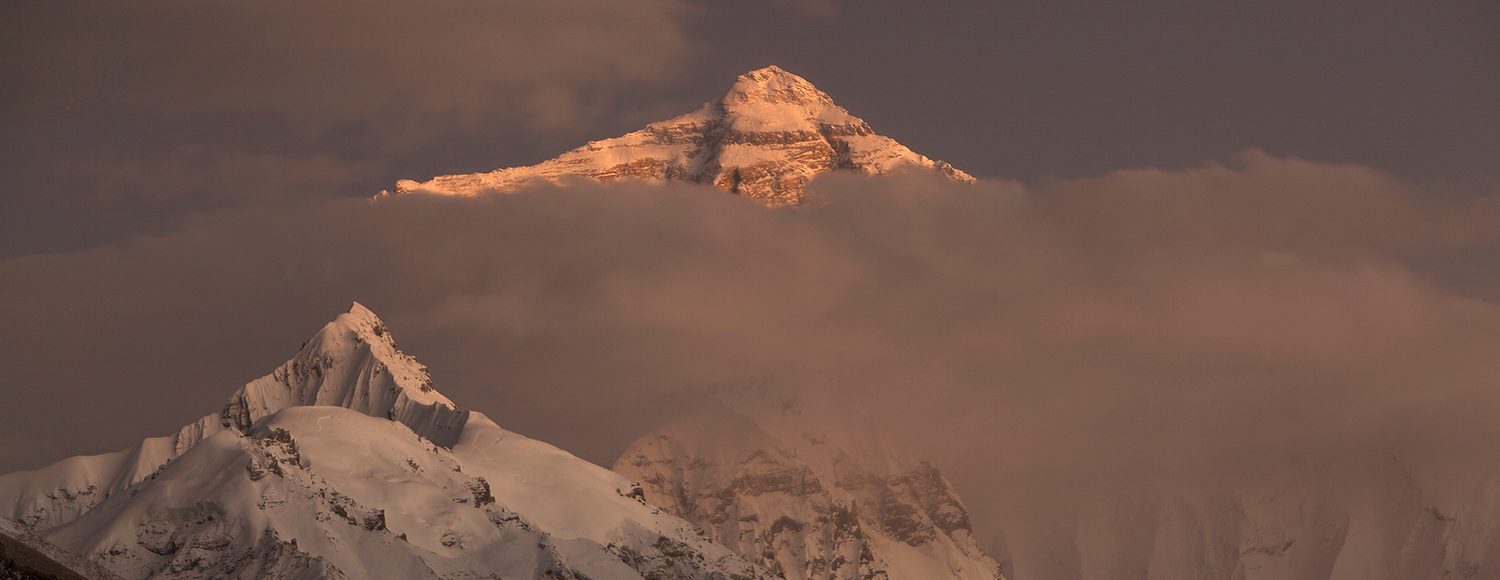NEPAL
Everest Base Camp Trek – Nepal
Himalaya – the name says it all. Straddling the border between Tibet and its southerly neighbor, the Kingdom of Nepal, the world’s tallest mountains soar to the heavens, seemingly piercing the unimaginably blue Tibetan skies. For the peoples of the Himalayan kingdoms, these mountains are sacred; for on their lofty heights dwell the gods and goddesses of the Indic religious traditions of Hinduism, Jainism, and Buddhism. In fact, the mountains themselves are considered manifestations of the deities.
Rising above them all is the “goddess” of all mountains, the colossal Everest. Reaching a stupendous 29,017 feet, the world’s tallest mountain exerts a powerfully magnetic pull. Indeed, for many an intrepid explorer, the lure of the summit has proved irresistible, albeit at times tragically so. Known as “Peak XV” by the early Indo-British surveying team that established its summit as the world’s highest, the mountain was later named after Sir George Everest, head of the Great Trigonometrical Survey. While this is the name by which most Westerners know the mountain, to Tibetans it is Chomolangma, “The Goddess Mother of the Universe,” while to Nepalis it is Sagarmatha, “The Forehead of the Sky.”
We begin our journey in the hustle and bustle of Kathmandu before taking the breathtaking mountain flight to Lukla, our trailhead. We then undertake the popular trek to bask in the glory of Everest’s majestic south face in the Khumbu, land of the Sherpa. Staying in comfortable mountain lodges or private camps, we hike along the historic trekking route that was pioneered by the like of Sir Edmond Hillary and Tenzing Norgay.

DATES: | Oct. 23 - Nov. 6, 2021 (15 Days) |
2-3 TREKKERS: | $5,885 Per Person |
4-8 TREKKERS: | $5,385 Per Person |
SINGLE SUPPLEMENT: | $450 Per Person (Kathmandu only) |
2-3 TREKKERS: | $5,485 per person |
4-8 TREKKERS: | $5,310 per person |
SINGLE SUPPLEMENT: | $450 per person |
INTERNAL NEPAL AIRFARE: | $1,300 per person |
SINGLE SUPPLEMENT: | $450 per person |
Inclusions & Exclusions
LAND PRICE INCLUDES:
• All accommodations based on double occupancy in Hotels/Lodges as listed in the itinerary, inclusive of all taxes and service charges
• All ground transportation using private A/C vehicles within Nepal
• Kathmandu sightseeing with experienced English-speaking local guides
• All meals after arrival in Nepal (dinner Day 1 to breakfast Day 15)
• All arrival/departure airport/hotel transfers
• All entry fees at all temples, museums and monuments on sight seeing excursions.
• Full service trek (all meals & snacks on trek, Sherpa trek guides, sleeping bags, sleeping pads, porters, yaks, and if required personal & toilet tents).
• All fees for Trek Permit, Sagarmatha National Park fees, conservations fee
• Services of Nomadic Expeditions Nepalese Trek Leader
LAND PRICE DOES NOT INCLUDE:
• International airfare to and from Kathmandu
• Internal Nepal (Kathmandu-Lukla-Kathmandu) flights
• Meals or hotels in transit cities en route to Nepal
• Gratuity to local staff (trek staff, porters, drivers, bell boys, etc.).
• Gratuity to Trek Leader
• Items of a personal nature, such as alcoholic beverages, laundry, phone calls, etc.
• Movie, video and still camera fees.
• Trip cancellation, travel delay or baggage insurance.
• Charges incurred as a result of delays beyond Nomadic Expeditions
DATES: | Oct. 23 - Nov. 6, 2022 (15 Days) |
2-3 TRAVELERS: | $6,045 Per Person |
4-8 TRAVELERS: | $5,585 Per Person |
SINGLE SUPPLEMENT: | $525 Per Person (Kathmandu only) |
Inclusions & Exclusions
LAND PRICE INCLUDES:
• All accommodations based on double occupancy in Hotels/ Lodges as listed in the itinerary, inclusive of all taxes and service charges
• Kathmandu-Lukla-Kathmandu flights
• All ground transportation using private A/C vehicles within Nepal
• Kathmandu sightseeing with experienced English-speaking local guides
• All meals after arrival in Nepal (dinner Day 1 to breakfast Day 16)
• All arrival/departure airport/hotel transfers
• All entry fees at all temples, museums and monuments on sight seeing excursions.
• Full service trek (all meals & snacks on trek, Sherpa trek guides, sleeping bags, sleeping pads, porters, yaks, and if required personal & toilet tents).
• All fees for Trek Permit, Sagarmatha National Park fees, conservations fee • Services of Nomadic Expeditions Nepalese Trek Leader
LAND PRICE DOES NOT INCLUDE:
• International airfare to and from Kathmandu
• Meals or hotels in transit cities en route to Nepal
• Tips/gratuity to local staff (trek staff, porters, drivers, bell boys, etc.).
• Tips/gratuity to Trek Leaders
• Items of a personal nature, such as alcoholic beverages, laundry, phone calls, etc.
• Movie, video and still camera fees.
• Trip cancellation, travel delay or baggage insurance.
• Charges incurred as a result of delays beyond Nomadic Expeditions
NOMADIC EXPEDITIONS
Our Guide
ICONIC NEPAL WITH EVEREST
Photo Gallery
NEPAL
MAP
Reviews
RELEVANT BLOGS
Everest Three Ways
Everest Three Ways Mt. Everest has a universal appeal. It is the highest point on the planet. It also represents the physical aspect of the heights of human achievement. And...
READ MOREItinerary
Download ItineraryOnce you have cleared the formalities of customs, immigration, you step into the receiving area where you will be met by our Nepalese Guide and escorted to the Yak & Yeti. “Namaste” is the greeting you will receive from the friendly Nepalese people, a traditional Hindu greeting, derived from Sanskrit, which means “I salute the soul (God?) within you.” We will check in to our hotel, the classic Yak & Yeti, before spending the afternoon taking in some of the sites of Kathmandu.
In the late afternoon we will have an orientation meeting to discuss the effects of high altitude and check our trekking gear (Kathmandu is a great place to get completely outfitted with trekking/climbing gear, in case you forgot something). After the meeting we will take a walking tour of “old Kathmandu,” including Durbar Square, Hanuman Dhoka, the ancient palace of the Gorkha Kings and the old bazaar, ending with a “welcome dinner.”
(Yak & Yeti Hotel, B,L, D)

We begin our Everest trek with an exciting flight in a Twin Otter plane to the small airstrip at Lukla, elevation 9,275 feet, where we will meet our trekking staff. Well-rested from two days of light activity, we hit the trail with renewed enthusiasm. The first day’s walk is moderate, as we make our way down from Lukla to the Dudh Kosi (the “Milk River,” named for its color). Hike up the valley to the village of Monjo.
(Mount Kailash Lodge; B, L, D)

Today will be a long and challenging day with many ups and downs to Namche, with an extended and steep hill trail leading into Namche Bazaar (11,300 ft). Along the trail are villages interspersed with forests of rhododendron, magnolia trees, and giant firs. Towards the end of the day, about halfway up the final hill to Namche, we find our first views of the snowed-capped summits of Lhotse (27,916 feet) and Mt. Everest (29,035 feet).
Arranged in a steep amphitheater at 11,300 feet, the town is packed with shops and small lodges, not to mention the winter homes of many prominent Sherpa families. Namche is the trading center for the entire Khumbu region, and the nexus of Sherpasocial life. We stay is a lodge founded by Pasang Kame (a famed Everester) in what is “ground zero” for Everest climbs. Most of the well-known Everest summitters have stayed here at one time or the other and lend their names to the various rooms. We will walk about the bazaar and explore the heart of the Sherpa community.
(Khumbu Lodge; B, L, D)

Today will be an easy day as we enjoy a leisurely breakfast before taking a two hours hike to our next location, the scenic village ofKumjung. It is here that Ed Hillary started his first school for the Sherpa community and this is also the site of the Kunde Hospital. Our lodge here is built to offer magnificent views of Mt. Amadablam (pictured above). Being a full moon we will have the opportunity of photographing the full moon rise against the high peaks of the Himalaya.
(Amadablam Lodge; B, L, D)

The morning takes us downhill, through terraced fields and pastures to our lunch site at Phunko Tenga, amid colorfully painted Buddhist prayer wheels, turning slowly by waterpower. Crossing the foaming Dudh Kosi River on a footbridge we start our long, steady climb through a pine forest to one of the most beautiful spots in the Himalaya, the monastery called Thyangboche, where, at 12,687 feet, we stay in the adjacent Guesthouse.
Thyangboche offers one of the most stunning panoramas in the Himalaya: Tawoche (2l,463 feet), Nuptse (25,843 feet), Mt. Everest (29,035 feet), Lhotse (27,9l6 feet), Ama Dablam (22,493 feet), Kangtega (22,235 feet), Thamserku (2l,806 feet), and Kwande (20,806 feet). Founded some fifty years ago by Lama Gulu, the monastery is the main spiritual center of the Khumbu.
The main temple was destroyed by an earthquake in l933, was reconstructed and again destroyed by a fire in 1989, and, with the assistance of many trekkers, the monastery has once again been rebuilt. Buddhism is believed to have been introduced into the Khumbu towards the end of the 17th century by Lama Sange Dorje, the fifth of the reincarnate lamas of the Rongbuk Monastery in Tibet on the other side of Mt. Everest. According to local legend, Sange Dorje flew over the Himalayas and landed on rocks at Pangboche and Tengboche, where he left his footprints.
Sunrise and sunset are magnificent, with the rocky tip of Everest peeping from behind the dramatic Lhotse/Nuptse wall, thebeautiful Ama Dablam, and many other peaks shifting through the pink spectrum of alpenglow colors.
(Guest House at Thyangboche; B, L, D)

These two days are designed to acclimate and are spent hiking in the high country surrounded by Everest and all of its satellite peaks. The trek leader will determine how far and which viewpoints that the group will visit. This will be based on the strength and acclimatization of the group. Our experience has been almost all trek members make the hike to Everest’s Base camp.
Leaving Tangboche we hike through a forest of birches, conifers and rhododendrons, crossing the Imja Khola, we climb up to Pangboche and then reach Dingboche by mid-afternoon, where we will stay for two nights. Our acclimatization hike will take to spectacular viewpoints – see another face of Amadablam, Island Peak and Makalu.
(Dingboche Lodge; B, L, D)

From Dingboche we hike through the high alpine region, across the glacial frozen river at Thukla and climb up hill to the Lobouche. Our lodge at Lobouche offers magnificent views of Cholatse, Lobouche, Pumori, and Nuptse. From Lobouche we are within striking distance of both, Everest’s Base Camp and the peak of Kala Pathar.
(Lobuche Lodge; B, L, D)

Directly opposite Everest, Kala Pathar (18,200 ft) offers some of the best panoramic views of Everest. In fact, most of the famous pictures of Mt. Everest’s rock pyramid peak are taken from Kala Pathar. We have a relaxed morning and after an early lunch, we start our slow but steady climb (no technical climbing required), reaching the black stone peak of the mountain by late afternoon. After spending some time on the peak (we may stay to watch the setting sun light up Everest’s rocky summit) and talking a number of photographs we descend to our lodge at Gorak Shep.
(Gorak Shep Lodge; B, L, D)

An early start is essential so that we can have few hours at the Base Camp.
We can see Khumbu Glacier as we approach Gorakshep, where we will take a short break before hiking into the Base Camp Area. We will see the spring climbing expedition camps in the base area and have an opportunity to meet with some Everest climbers. The base camp also offers views of the dramatic Khumbu Glacier. The actual summit of Everest is hard to see from this location as we are so close to the mountain. Return hike to Periche for the overnight.
(Himalaya Lodge; B, L, D)

We will start our return trek to Lukla airport. Our first day’s descent will bring us to the monastery of Thyangboche where we have lunch and then continue all the way to Namche (11,300 ft.). We should arrive in Namche with enough time for you to do some last minute shopping in Namche’s Bazaar and a welcome “hot shower.”
(Khumbu Lodge; B, L, D)

Today we end our trek by climbing back up to Lukla. Tonight we will have our final dinner with our trekking staff and bid them farewell as we rise early the next morning to catch our flight back to Kathmandu.
(Northface Lodge; B, L, D)

We say goodbye to our trekking staff, and prepare to make the return to Kathmandu. Weather permitting the morning flight will get us back to the Nepali capital, where we will return to the cozy confines of the Yak & Yeti Hotel. The remainder of the day will be at your leisure to shop, wander the bazaars, and enjoy exotic Kathmandu.
(Yak & Yeti Hotel; B, L, D)

This day serves as a back-up day for us to fly out from Lukla, in case the flight was cancelled the day before because of inclement weather.
Kathmandu’s legendary temple sites and stupas are truly amazing and are simultaneously revered as sacred reliquaries and bustling with contemporary social life. The eyes of the Lord Buddha gaze serenely upon the Kathmandu Valley from atop the photogenic stupa at Swayambunath, also known as the Monkey Temple. The large Buddhist stupa Bodnath, a World Heritage Site, is equally renowned. Bodnath is also home to a sizeable Tibetan community and is a wonderful place to witness traditional Buddhist ritual, as well as to shop for Tibetan arts and crafts. Kathmandu is also home to the great Hindu temple at Pashupatinath, located on the banks of the Bagmati River. This is a major pilgrimage site for the followers of Shiva, drawing Hindu faithful from around the world. Although the temple is off-limits to non-Hindus, travelers can still visit the temple precincts and view the temple from the opposite bank of the Bagmati. From here, one can see the temple’s cremation ghats and witness firsthand the Hindu cycle of life.
This evening we will gather for a special Farewell Dinner, as we bring our incredible journey to a close.
(Yak & Yeti Hotel; B, L, D)

After breakfast we will be transferred to Kathmandu’s airport in time for the outbound flight.









